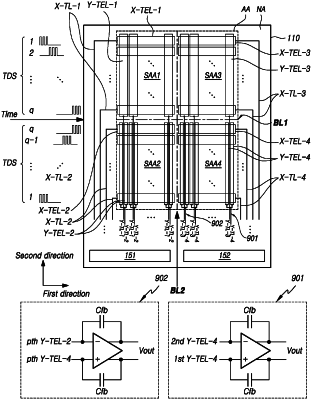| CPC G06F 3/04166 (2019.05) [G06F 3/04184 (2019.05)] | 17 Claims |

|
1. A touch display device, comprising:
a plurality of light-emitting elements on an active area of a display panel;
an encapsulation layer on the plurality of light-emitting elements;
a plurality of X-touch electrode lines on the encapsulation layer, the plurality of X-touch electrode lines comprising two or more X-touch electrodes electrically connected to each other along a first direction, and disposed on each of a plurality of sub-areas included in the active area separately;
a plurality of Y-touch electrode lines on the encapsulation layer, the plurality of Y-touch electrode lines comprising two or more Y-touch electrodes electrically connected to each other along a second direction that crosses the first direction, and disposed on each of the plurality of sub-areas separately; and
a plurality of touch routing lines electrically connected to the plurality of X-touch electrode lines and the plurality of Y-touch electrode lines,
wherein the plurality of sub-areas comprise a first sub-area and a second sub-area which are divided by a boundary along the first direction, and
wherein a driving period of a first X-touch electrode line from a plurality of first X-touch electrode lines disposed on the first sub-area which is closest to the boundary along the first direction is synchronized with a driving period of a second X-touch electrode line from a plurality of second X-touch electrode lines disposed on the second sub-area which is closest to the boundary of the first direction such that at least a portion of the driving period of the first X-touch electrode line overlaps at least a portion of the driving period of the second X-touch electrode line,
wherein each of the plurality of first X-touch electrode lines is driven sequentially along one direction, and each of the plurality of second X-touch electrode lines is driven sequentially along an opposite direction of the one direction while a corresponding one of the plurality of first X-touch electrode lines is driven.
|